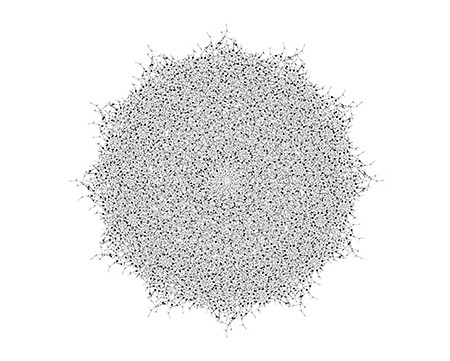
REVIEW: Dornith Doherty Exchange in ArtLTD Magazine
May 1, 2015 - John Zotos
Dornith Doherty: “Exchange” at Holly Johnson Gallery by john zotos May 2015
Now in her third decade as a working artist, Dornith Doherty has never seemed to slow down or stop probing into the relationship between our place on this planet and how it responds to our presence. No mistake then that her latest show exhibits a steadfast intent to explore global ecological systems through the lens of her mesmerizing photo collages. Her current work is related to a long relationship, and collaboration, with seed banks, both at home and abroad, through which she acquires X-ray photographs of individual seeds and plant tissue. These photographs provide the source material for the digital information that’s copied, overlaid and spliced by computer editing into a final image. Doherty’s research has been funded by numerous awards, most notably a 2012 Guggenheim Foundation Fellowship, that led to her travel to three separate facilities in Australia to photograph threatened plants. The title of the current exhibition,
“Exchange,” refers to scientists across the globe that trade and relocate endangered species of plant life, but for Doherty this also acts as a metaphor and description of her collage aesthetic and the use of the images she combines into unique works of art that prompt further queries. In Epiphyte (2014), plantlike tendrils join the magnified samples of seeds, forming a spherical shape that radiates from a perfect center. With an almost fractal-like sensibility the joined lines thread through the surface, ending at the outer edge with a symmetrical arrangement of jagged tail-ends circling the perimeter in intervals, as if the process of expansive growth is still in motion. Her collage process lends a strong force to the seed particles that suggest a consideration of genetic splicing and evolution, a possible counter to global dissolution, with a positive reading of human agency on Earth. By contrast, Spiral Grass (2014), is also a spherical construction but has a less dense and more chaotic inner arrangement of seed forms copied into varying shapes, surrounded by a cropped perimeter that forms a perfect circle on the outer edge. This piece looks as if the expansion is complete, a stasis achieved by a motionless tranquility. Other pieces in the show take the collage elements out of the spherical, which always seem like globes or building blocks, into freer configurations that resemble celestial images from outer space. This inversion perfectly attests to the versatility and vitality of Doherty’s vision.
Download Article (PDF)Back to News
